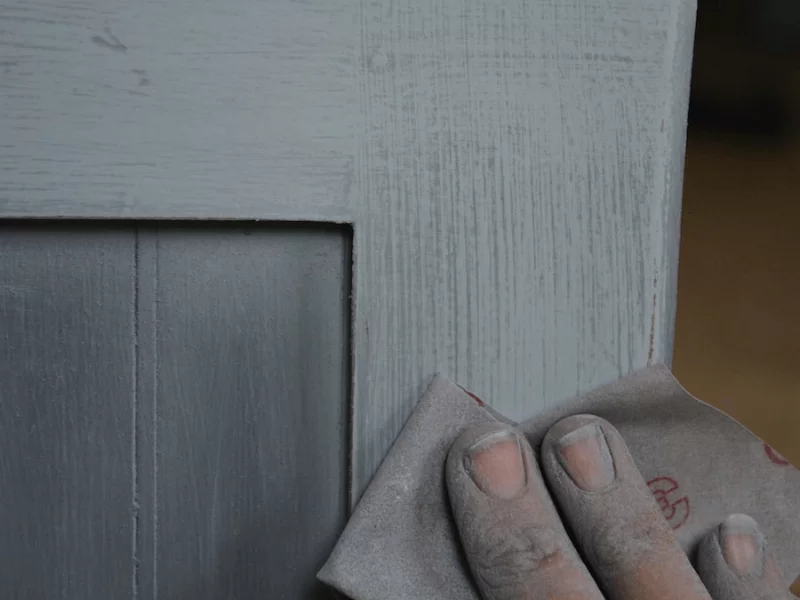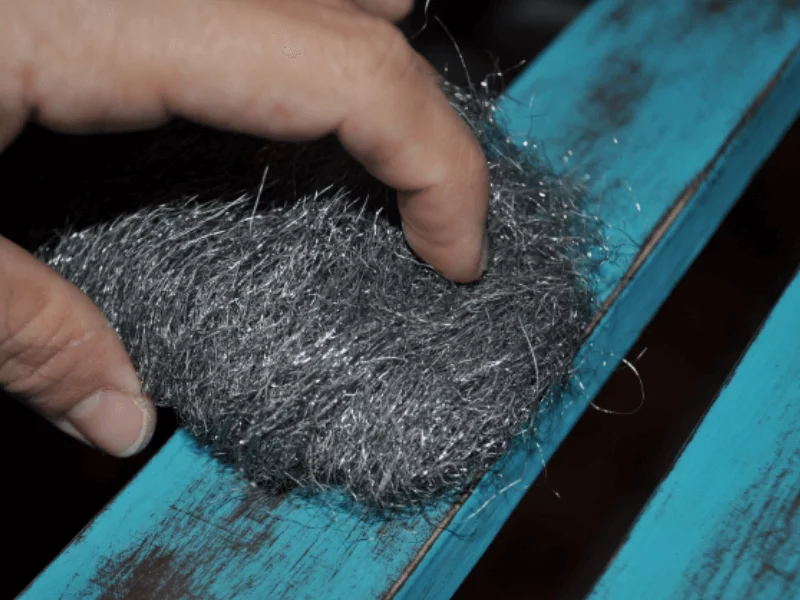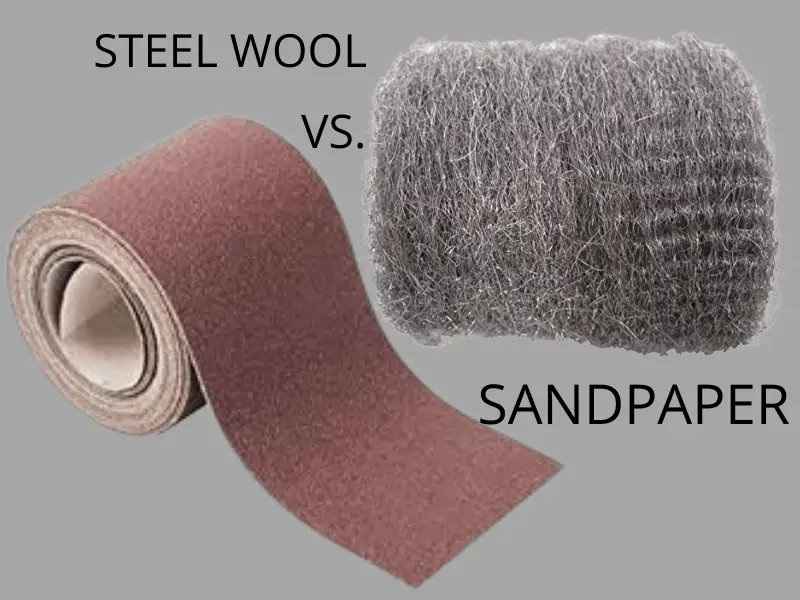Though the wood’s surface looks good after you’ve run it through the jointer, table saw, or planer, it’s not. All these machines leave their marks; the problem is that those marks often aren’t visible on bare wood.
Unfortunately, they’ll be exemplified once a clear finish or stain is applied. All lumber coming off a machine needs further smoothing and levelling. But you can choose from several different types of abrasives at the hardware store, and it can be challenging to determine which one is right for your specific project. But steel wool and sandpaper are the most common.
Here’s what you need to know about steel wool vs. sandpaper to ensure you use the suitable material!
If you are already reading this, you may have wondered what the difference between the two is and what you should do. This article will cover that and much more, so keep reading.
sandpaper

Sandpaper is an abrasive for smoothing and polishing wood, metal, or other surfaces. It’s made from paper with heavy grit on one side and light grit on the other. The more severe spirit removes more material than lightweight grit, so it should be used for rougher surfaces like concrete.
There are two main types of sandpaper: silicon carbide and aluminium oxide. Silicon carbide has a more complex abrasive grain than aluminium oxide. It works well for rough surfaces and hard materials such as wood finishes. On the other hand, aluminium oxide is more irregular and has a coarser texture than silicon carbide. It is the most commonly used abrasive grain in projects such as woodwork and metalwork.
What is sandpaper used for?
Most commonly, sandpaper is used to sand down wood, remove paint or varnish, and smooth rough edges on various surfaces. It’s also great for removing rust from metal surfaces. The different types of sandpaper are determined by the abrasiveness of the paper – with coarse sandpaper being the most abrasive and fine sandpaper being the least.
Drawback of sandpaper
- It can’t be reused like steel wool can.
- It doesn’t come in many colours and patterns, so you can’t customize your project to match your home decor as you can with steel wool.
- Also, because sandpaper is made up of tiny pieces of abrasive material, some people may find that it scratches off the surface over time more than you might want. However, if what you’re trying to do isn’t too detailed or intricate, this may not matter to you!
Steel wool

Steel wool is made of fabulous steel strands twisted together to form a thick, abrasive pad. It’s commonly used for scrubbing tough stains and cleaning surfaces that are difficult to reach. Unlike sandpaper, steel wool can be reused and even reshaped if necessary.
What is Steel wool used for?
Steel wool is often used as an abrasive material. It is most commonly used to clean surfaces or remove paint. Additionally, steel wool can be used to scrub pots and pans, polish metals, and clean windows. When using steel wool, it is essential to be aware that it can rust if left wet.
The drawback of steel wool
The main drawback to steel wool is that it can be pretty messy. It’s also important to be careful when using it, as it can easily scratch surfaces if you’re not careful. Also, steel wool can rust if wet, so it’s not the best choice for outdoor projects. Finally, steel wool is more expensive than sandpaper.
Does steel wool work like sandpaper?
Many people don’t know that steel wool and sandpaper are pretty similar. Both are made of tiny particles that can be used to smooth or clean surfaces. The main difference is that steel wool is made of metal, while sandpaper is made of sand.
But does this make one better than the other? That’s for you to decide! For those who like a little variety, we recommend using both on different projects and seeing which works best for your needs. If you want to use steel wool as well as sandpaper, here are some ways they can work together to give your home an updated look:
- Use the coarse grade of sandpaper on the furniture legs.
- Use fine-grade sandpaper to buff out scratches on wood surfaces.
- Use steel wool to remove rust from chrome fixtures and sinks.
- Use coarser sandpaper grades to remove paint from window sills and trim boards.
- If you’re refinishing a kitchen countertop, go with sandpaper because steel wool can’t be used for this project due to the risk of damaging the countertop finish.
- Use steel wool to clean up some scratches on your dining room table. Sandpaper is inappropriate because it cannot remove minor scratches like steel wool.
It’s always important to remember that different projects require different types of abrasives! Neither one can replace the other, so keep both stocked in your toolbox so you’ll always have the right product!
Which one is easier to use?
Regarding household abrasives, there are two clear contenders: steel wool and sandpaper. So, which one is easier to use? It all depends on what you’re trying to do! If you’re looking for a way to polish wood, sandpaper would be your best bet; if you want something for scouring pots and pans, go with steel wool. In the end, both tools have their place in your home. Steel wool is excellent for removing rust from metal items, whereas sandpaper can smooth out rough edges on various surfaces.
Generally, it would be best to use steel wool for anything involving wood or metal, while sandpaper is suitable for most everything else. In short, if you need to remove paint or rust, go with steel wool. If you’re working with wood, go with sandpaper.
Remember that there are exceptions to every rule, though—don’t get too caught up in adhering strictly to these recommendations, or else you might miss an opportunity for your project. That said, once you learn how to recognize which project needs which abrasive, it will make all the difference in your home improvement projects!
Safety Tips to put into consideration
Steel wool and sandpaper are standard household abrasives, but using them safely is essential.
When handling either material, always wear gloves and keep them away from children and pets.
– When using sandpaper, work in a well-ventilated area, as the dust can be harmful if inhaled. And always clean up thoroughly after using either abrasive, as they can be dangerous if left lying around.
So while they have their differences, these two abrasives have yet to have a clear winner. It all depends on what you’re trying to accomplish!
steel wool vs. sandpaper
You should be aware that some people in woodworking refuse to use sandpaper and choose steel wool as the abrasive of choice for sanding between coats of clear finish and then wonder why they haven’t been able to achieve a smooth finish.
Steel wool will not give the surface enough of a scuff or tooth for the next coat of finish. Don’t get me wrong: steel wool is excellent and abrasive, but it’s best for polishing final finishes rather than prep work between coats of clear finish, especially when dealing with raised water-based grain products.
Steel wool cannot eliminate the surface bumps of the particulate matter that has fallen onto and dried in the varnish or polyurethane. It would be best if you used finishing sandpaper. Abrading a dried coat of water-based finish with steel wool before re-coating can be problematic.
If you fail to get all the steel wool dust from the surface, the dust can be trapped between layers of the finish, and specks of black spots may appear in the finish. Not so bad if it’s dark wood, but on a natural oak or maple surface? You can do nothing to get rid of these annoying little specs except strip the work down to the bare wood, apply bleach if there are any residual stains, or apply a large doily and a vase containing the flower of your choice. Use sandpaper between finish coats!
Additional Tips
There are different steel wool types, so ensure you get the right one for your project.
Sandpaper has various grits, so choose the right one for your needs.
You can use sandpaper wet or dry, but steel wool is most suitable for dry use as it is prone to rust.
Steel wool will leave behind tiny pieces of metal, so be careful where you use it.
Wear protective gear like gloves and goggles if using sandpaper because harmful particles are released into the air.
-With both abrasives, don’t forget to wear safety glasses to protect your eyes from flying particles.
-Lastly, steel wool and sandpaper have similar costs per square foot
Conclusions
So there you have it, a quick rundown of steel wool and sandpaper and their pros and cons. Ultimately, the best abrasive to use is the one that fits your needs the most. If you need to remove paint quickly, sandpaper will be your best friend. But if you’re looking for a more gentle touch, steel wool is probably the way to go. Steel wool can make your chores easier when appropriately used by removing tough dirt without scratching delicate surfaces.
And if you’re not sure, test both out and see which works better for your project. With all that said, remember to keep these two abrasives separate in storage because they’ll be attracted to each other. Lastly, always wear protective gear when using these items.

